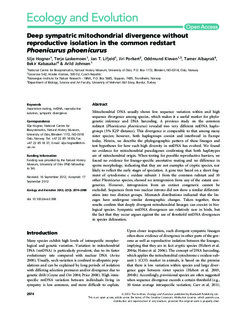| dc.contributor.author | Hogner, Silje | |
| dc.contributor.author | Laskemoen, Terje | |
| dc.contributor.author | Lifjeld, Jan Terje | |
| dc.contributor.author | Porkert, Jiri | |
| dc.contributor.author | Kleven, Oddmund | |
| dc.contributor.author | Albayrak, Tamer | |
| dc.contributor.author | Kabasakal, Bekir | |
| dc.contributor.author | Johnsen, Arild | |
| dc.date.accessioned | 2017-08-04T07:31:30Z | |
| dc.date.available | 2017-08-04T07:31:30Z | |
| dc.date.created | 2012-11-21T10:15:46Z | |
| dc.date.issued | 2012 | |
| dc.identifier.citation | Ecology and Evolution. 2012, 2 (12), 2974-2988. | nb_NO |
| dc.identifier.issn | 2045-7758 | |
| dc.identifier.uri | http://hdl.handle.net/11250/2449875 | |
| dc.description.abstract | Mitochondrial DNA usually shows low sequence variation within and high sequence divergence among species, which makes it a useful marker for phylogenetic inference and DNA barcoding. A previous study on the common redstart (Phoenicurus phoenicurus) revealed two very different mtDNA haplogroups (5% K2P distance). This divergence is comparable to that among many sister species; however, both haplogroups coexist and interbreed in Europe today. Herein, we describe the phylogeographic pattern of these lineages and test hypotheses for how such high diversity in mtDNA has evolved. We found no evidence for mitochondrial pseudogenes confirming that both haplotypes are of mitochondrial origin. When testing for possible reproductive barriers, we found no evidence for lineage-specific assortative mating and no difference in sperm morphology, indicating that they are not examples of cryptic species, nor likely to reflect the early stages of speciation. A gene tree based on a short fragment of cytochrome c oxidase subunit 1 from the common redstart and 10 other Phoenicurus species, showed no introgression from any of the extant congenerics. However, introgression from an extinct congeneric cannot be excluded. Sequences from two nuclear introns did not show a similar differentiation into two distinct groups. Mismatch distributions indicated that the lineages have undergone similar demographic changes. Taken together, these results confirm that deeply divergent mitochondrial lineages can coexist in biological species. Sympatric mtDNA divergences are relatively rare in birds, but the fact that they occur argues against the use of threshold mtDNA divergences in species delineation. Assortative mating, mtDNA, reproductive isolation, sympatric divergence | nb_NO |
| dc.language.iso | eng | nb_NO |
| dc.rights | Navngivelse 4.0 Internasjonal | * |
| dc.rights.uri | http://creativecommons.org/licenses/by/4.0/deed.no | * |
| dc.title | Deep sympatric mitochondrial divergence without reproductive isolation in the common redstart Phoenicurus phoenicurus | nb_NO |
| dc.type | Journal article | nb_NO |
| dc.type | Peer reviewed | nb_NO |
| dc.description.version | publishedVersion | nb_NO |
| dc.subject.nsi | VDP::Matematikk og Naturvitenskap: 400::Zoologiske og botaniske fag: 480 | nb_NO |
| dc.source.pagenumber | 2974-2988 | nb_NO |
| dc.source.volume | 2 | nb_NO |
| dc.source.journal | Ecology and Evolution | nb_NO |
| dc.source.issue | 12 | nb_NO |
| dc.identifier.doi | 10.1002/ece3.398 | |
| dc.identifier.cristin | 963818 | |
| dc.relation.project | Norges forskningsråd: 213592 | nb_NO |
| dc.relation.project | Norges forskningsråd: 196554 | nb_NO |
| cristin.unitcode | 7511,2,0,0 | |
| cristin.unitname | Avdeling for terrestrisk økologi | |
| cristin.ispublished | true | |
| cristin.fulltext | original | |
| cristin.qualitycode | 1 | |

